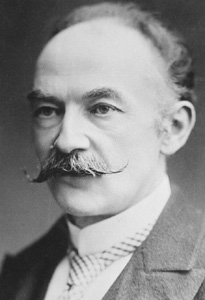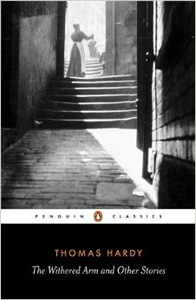
photo © David Frankel, 2014
by Christine Genovese
Fairy tales are part of everybody’s basic literary baggage. There are fairy tales lurking at the back of every writer’s memory asking to be let into their work. Sometimes they sneak imperceptibly into the wings, while at other times they stride straight into the limelight. In the nineteenth century, interest in fairy tales was huge. The Brothers Grimm and Hans Andersen dominated the scene by the 1850s, but the public had already enjoyed a wide variety of magical tales through the Arabian Nights, Madame d’Aulnoy and Sir Walter Scott… to say nothing of the Gothic tales and the popular penny dreadfuls. Thomas Hardy wanted to be remembered for his poetry; today’s readers are more familiar with his novels. But there is every reason to remember him also for his fifty-five or so short stories, which include some masterful examples of the form.
One of Hardy’s earliest stories, ‘The Thieves Who Couldn’t Stop Sneezing’, follows a pattern familiar to readers of fairy tales, except for one detail: the element of magic is reduced to a protagonist pretending to be a magician who can make strange noises emerge from an alcove. Hardy wrote the story for The Father Christmas Annual of 1877, which was aimed at teenage boys. The protagonist of the story, Hubert, is a fourteen-year-old boy who, like other fairy tale boys before him (such as Jack, in ‘Jack and the Beanstalk’), is bold and bright enough to overcome adversity.
 The fairy tale format and the recognisable Wessex setting mix together well. Hubert is attacked by thieves who steal his horse. He staggers away from the ditch where the thieves have left him and arrives at a mansion where the door is wide open and a sumptuous feast is laid out in the dining hall, but there’s no one in sight. With the help of his host’s snuff-box, Hubert exposes the thieves and their malevolent plans. He leaves the mansion after finding his horse and magnanimously refuses a reward.
The fairy tale format and the recognisable Wessex setting mix together well. Hubert is attacked by thieves who steal his horse. He staggers away from the ditch where the thieves have left him and arrives at a mansion where the door is wide open and a sumptuous feast is laid out in the dining hall, but there’s no one in sight. With the help of his host’s snuff-box, Hubert exposes the thieves and their malevolent plans. He leaves the mansion after finding his horse and magnanimously refuses a reward.
These are typical fairy tale elements, with antecedents going right back to ‘Sir Gawain and the Green Knight’, and the story’s happy ending also belongs to the classical fairy tale. However, Hardy supplies rational explanations for everything in the story. He was not inclined to use magic as a deus ex machina that conveniently puts the world to rights. He was often criticised for his pessimism and countered such criticism by saying that he aimed for the harmony of truth. In the General Preface to The Wessex Edition of 1912 (the definitive collection of Hrdy’s works), Hardy wrote:
Existence is either ordered in a certain way, or it is not so ordered, and conjectures which harmonise best with experience are removed above all comparison with other conjectures which do not so harmonise.
‘The Withered Arm’ is not a fairy tale. It is the story of two women and their relationship with one man. Rhoda Brook, a milking-woman, is the former mistress of Farmer Lodge and mother of his son. Gertrude Lodge, the farmer’s legitimate wife, befriends Rhoda and Rhoda’s son when her husband brings her to the village. Rhoda responds politely, as she realises Gertrude is unaware of the situation. When Gertrude appears to Rhoda in a dream, Rhoda defends herself by gripping the vision’s arm. When, in real life, Gertrude loses the use of her arm she seeks Rhoda’s help and is taken to see Conjuror Trendle. Gertrude’s arm and marriage deteriorate and years later she consults Trendle again. He tells her that she can be cured by touching the neck of a hanged man. When Gertrude is about to have the cure, Rhoda and Lodge arrive and reveal that the hanged man is their son. He’s been hanged for arson. The tragedy concludes when Gertrude faints and dies. Lodge and Rhoda go their separate ways.
Hardy presented The Wessex Tales as a record of the traditions and customs of ordinary country folk. In his preface to the 1896 edition, he apologised to the reader for getting some of the ‘facts’ about ‘The Withered Arm’ wrong:
Since writing this story some years ago I have been reminded by an aged friend who knew ‘Rhoda Brook’ that, in relating her dream, my forgetfulness has weakened the facts out of which the tale grew. In reality it was while lying down on a hot afternoon that the incubus oppressed her […] To my mind, the occurrence of such a vision in the daytime is more impressive than if it had happened in a midnight dream. Readers are therefore asked to correct the misrelation, which affords an instance of how our imperfect memories insensibly formalise the fresh originality of living fact.
The obedient reader suspends disbelief. The brief and disturbing incident of an incubus dream is pivotal to the story. It paints a cynical picture of the dilemma that faces Rhoda and Gertrude, although neither woman was aware of such foul feelings hidden deep down in their subconscious.
Rhoda Brook dreamed […] that the young wife, in the pale silk dress and white bonnet, but with features shockingly distorted, and wrinkled as by age, was sitting upon her chest as she lay. The pressure of Mrs Lodge’s person grew heavier; the blue eyes peered cruelly into her face: and then the figure thrust forward its left hand mockingly, so as to make the wedding-ring it wore glitter in Rhoda’s eyes […] Gasping for breath, Rhoda, in a last desperate effort, swung out her right hand, seized the confronting spectre by its obtrusive left arm, and whirled it backward to the floor, starting up herself as she did so with a low cry.
“O, merciful heaven!” she cried, sitting on the edge of the bed in a cold sweat; “that was not a dream – she was here!”
She could feel her antagonist’s arm within her grasp even now – the very flesh and bone of it, as it seemed.
Hardy’s genius is in the smooth transition from dream to the real-life consequences of the vision. Gertrude must act to remove the curse, and she makes two visits to a sorcerer, Conjuror Trendle, who has the power to give her the answers she needs.
There are parallels between ‘The Withered Arm’ and Hans Andersen’s tale ‘The Little Mermaid’. They both tell the story of two women’s love for one man who trifles with one and marries another of his own social status. There’s the maiming of one of the women and two visits to a sorcerer, or sea-witch, to obtain help by magic. Hans Andersen wrote his stories for children and on the surface they are light in tone and full of lively and colourful descriptions. But this is often a thin veneer that disguises the social injustices and misery in the tales. Andersen’s stories often have a Christian moral at the end that softens the tragedy.
The magic that Hardy keeps out of ‘The Thieves Who Couldn’t Stop Sneezing’ weaves a constant thread through ‘The Withered Arm’. But it isn’t the sort of magic that puts the world to rights. The two women are thrown into a sequence of events that lead inexorably to the final scene; Hardy doesn’t allow magic to supply an easy fairy tale path to a happy ending. He also refused Andersen’s simple acceptance of God’s will.
There are similar comparisons to be drawn between Hardy’s story ‘The Fiddler of the Reels’ and Andersen’s ‘The Red Shoes’. Andersen’s tale tells the story of a young girl’s love of fashion, fun and partying. Despite the disapproval of society she wears her red shoes to church. A mysterious soldier with a red beard puts a curse on the shoes and Karen is compelled to dance forever until she meets an executioner who agrees to cut off her feet. Karen repents of her sins and the story ends with Karen’s death and a mystical vision of her church where she receives forgiveness. In ‘The Fiddler of the Reels’, Car’line is wooed by Ned Hipcroft, a simple, hard-working mechanic, but she’s infatuated with the fiddler Mop Ollamoor, whose music stirs her soul and her feet. When Ollamoor plays his fiddle, Car’line dances. He takes advantage, and Car’line ends up with a baby girl. Ned Hipcroft marries her despite the stigma and he dotes on the little girl. But Car’line is once more caught by the sound of the other man’s fiddle and dance she must, until she loses consciousness and her daughter is abducted by Ollamoor.
There are numerous other antecedents of ‘The Fiddler of the Reels’. The Grimm Brothers had a tale called ‘The Jew in the Thorns’ about a young man whose fiddling makes everyone dance. Similar tales exist in other cultures and some go back to the middle ages. Hardy’s story is masterful in creating a modern short story that keeps the compelling thrust of these fairy tales. Depicting the fiddler as a sexual predator, a seducer of young women, is a convincing touch, while he loses none of the demonic qualities of, say, The Big Bad Wolf and his ilk. Car’line, his poor innocent victim, hasn’t a hope of escaping.
 The magic in ‘The Fiddler of the Reels’ is illusory. Hardy does not pull rabbits out of hats. That would upset the balance. Mop Ollamoor has the allure of the devil, like the mysterious soldier with the red beard in Anderson’s story. No one has put a curse on Car’line, and yet the impulse to dance whenever the fiddler strikes up is as strong and irresistible as Karen’s urge to dance whenever she puts on her red shoes. The harmony of truth, as Hardy saw it, does not include unexpected reversals of fate that magic allows in stories. His stories follow their logical course. Car’line and Ned are stuck in a meaningless marriage. Rhoda grows old and wears the hair off her head leaning against the flanks of cows as she has done all her life.
The magic in ‘The Fiddler of the Reels’ is illusory. Hardy does not pull rabbits out of hats. That would upset the balance. Mop Ollamoor has the allure of the devil, like the mysterious soldier with the red beard in Anderson’s story. No one has put a curse on Car’line, and yet the impulse to dance whenever the fiddler strikes up is as strong and irresistible as Karen’s urge to dance whenever she puts on her red shoes. The harmony of truth, as Hardy saw it, does not include unexpected reversals of fate that magic allows in stories. His stories follow their logical course. Car’line and Ned are stuck in a meaningless marriage. Rhoda grows old and wears the hair off her head leaning against the flanks of cows as she has done all her life.
The setting in ‘The Fiddler of the Reels’ is Hardy’s beloved Wessex. There are scenes of family and social life that are firmly rooted there. The story’s realism is completely convincing, and yet at the same time it has the bewitching tang of a fairy tale.
Mop was standing on his door-step, as was his custom, spinning the insidious thread of semi- and demi-semiquavers from the E string of his fiddle for the benefit of passers-by, and laughing as the tears rolled down the cheeks of the little children hanging around him. Car’line pretended to be engrossed with the rippling of the stream under the arches, but in reality she was listening, as he knew. Presently, the aching of the heart seized her simultaneously with a wild desire to glide airily in the mazes of an infinite dance.
In an article in The Times Literary Supplement from November 2012, Marina Warner said:
The dream of a pure fountainhead, of the old crone storyteller passing on the wisdom of the tribe, is a principle of cultural nationalism, as well as a form of Romantic Pastoral…
This sentiment is echoed in Hardy’s work. His heart was in Wessex, and he wanted his writing to be a tribute to the social history and traditions of Wessex, much as the Brothers Grimm saw their stories as celebrating the literature of Germany as told by the common people. Many of his stories, like ‘The Withered Arm’, are retellings of oral tales he’s heard over the years.
The fact that fairy tales are anchored in the ancient traditions of the common people undoubtedly appealed to Hardy. Andersen’s stories had a modern slant to them that also appealed to him, but the Christian moral comfort that often supplied the happy ending of Andersen’s tales seemed as contrived to Hardy as the simple solution of the interference of magic powers. The nearest Hardy came to describing a mystical vision of religious proportions was probably the scene in Tess of the d’Urbervilles in which Tess, while listening to the hum of the pagan gods at Stonehenge, accepts her fate with equanimity: ‘The President of the Immortals, in Aeschylean phrase, had ended his sport with Tess.’
The magical elements in Hardy’s stories are far from supernatural. Hubert, in ‘The Thieves Who Couldn’t Stop Sneezing’ might pretend to be a magician, but his best course of action was to use his ingenuity and the snuff-box to stage the dramatic discovery of the thieves. The supernatural elements in ‘The Withered Arm’ do nothing to help the two women. They are mere markers in the story that lead to the tragic end.
Thomas Hardy didn’t write fairy tales. The lives of his characters follow their logical course, but the powerful spell of these stories over the imagination of writers was as strong in the nineteenth century as it is today.

